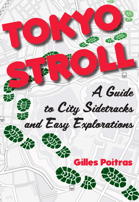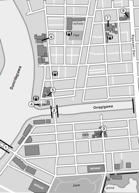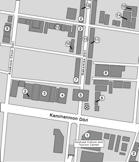











Tokyo Stroll Supplement: Koganei

This page is for locations in Koganei Tokyo. This area is not part of my book Tokyo Stroll.
For information on Tokyo Stroll and this web supplement see Tokyo Stroll Supplement home page
For users of the Organic Maps, Maps.Me and Google Maps apps the items below have bookmarks you can import into those apps to make navigation easier.
Instructions and links are on the Viewing Locations in Organic Maps, Maps.Me, Google Maps, or Google Earth page.
Some entries on this page may include a note that says "Description to be added soon ." These entries are for items I felt should be listed even if the description is not ready to assist those who wish to plan a trip. When possible I included a link to an official web page, I suggest also doing web searchs for more information.
Koganei Shi (小金井市)
Official pages for each of the cities and towns of will have sections of interest to visitors. These will likely be labeled as dealing with culture, tourism, or events.
Koganei Shi official site: https://www.city.koganei.lg.jp
Edo-Tokyo Open Air Architectural Museum / Edo-Tokyo Tatemono En (江戸東京たてもの園)
This museum was opened March 1993 by the Tokyo Metropolitan Government using seven-hectares in Koganei Park. It is an annex of Edo-Tokyo Museum (Tokyo Stroll, Ryōgoku Chapter, page 340). The buildings relocated here date from the Edo Period (1603-1867) through the Shōwa Period (1926-89). Included are private residences, a variety of shops, an izakaya, a kōban, a bath house, restaurants where you can still get a meal, thatched farm houses, even the remains of a 7th-century burial chamber that was already on the grounds, and more. Some of the buildings were used as references for the artists working on the anime feature Spirited away. The museum has special exhibits and even items such as a model 7500 street car from the 1960s, an electric light that used to be at the Imperial Palace, old bicycles, and a rickshaw with maki-e decoration, rickshaw with such decorations were outlawed in 1886 making this is the only one to have survived. There is a museum shop, a library, an exhibition room, diaper changing areas, a breast feeding room, stroller loan and wheel chair loan as most buildings have ramps, and even ostomate restrooms. The mascot of the museum, a green caterpillar named Edomaru, was designed by Miyazaki Hayao.
NEAREST TRAIN/SUBWAY STATION: Musashi-Koganei Station (JR Chūō Line). Higashi-Koganei Station (JR Chūō Line). Hana-Koganei Station (Seibu Shinjuku Line). You may want to take a bus rather than walk.
NOTES: Wear shoes that are easy to remove as you will need to take them off to enter some buildings.
CLOSED: Mondays, if Monday is a holiday they will be open and then close on Tuesday, closed for the New Years holidays
WEB: https://www.tatemonoen.jp/english/
Koganei Park / Koganei Kōen (小金井公園)
Opened in January 1954 as a very large, 79 hectares, park just north of the Tamagawa Jōsui (Tamagawa Aqueduct). Much of the park is wooded with a variety of trees including oaks, pines, magnolia, and over 1,700 cherry trees on the grounds, some of the trees are centuries old. There is a good bird watching area with a sanctuary in the northern part of the park. The park has a children’s playground, including an artificial turf sledding hill, and various sport facilities at the Koganei City Municipal Sports Complex such as an archery range for both Japanese (odd numbered days) and Western archery (even numbered days), a cycling course, a gateball court, a baseball field, sixteen tennis courts, a BBQ area, and dog runs. The use of some facilities involves a fee. For food there are Soba Tea House Sakura, a restaurant/store called Soba Tea House Sakura, and Parks Koganei a store where you can get snacks and toys. The grounds also include a CL57 steam locomotive, and the Edo-Tokyo Open Air Architectural Museum.
NEAREST TRAIN/SUBWAY STATION: Musashi-Koganei Station (JR Chūō Line). Higashi-Koganei Station (JR Chūō Line). Hana-Koganei Station (Seibu Shinjuku Line). You may want to take a bus rather than walk.
NOTE: You are expected to take your garbage with you when you leave.
WEB: https://www.tokyo-park.or.jp/park/koganei/
Nukui Shrine / Nukui Jinja (貫井神社)
Dating from 1590 when it was founded as the Nukui Benzaiten. In the Meiji Period, under the edicts calling for the separation of Buddhism and Shintō, the shrine was renamed Itsukushima Shrine in 1875 and the ujigami of Nukui Jinja in Nukui village was transferred here, making this now the guardian shrine of the Nukui area. From then on the shrine has been referred to as Nukui Jinja. The main hall was rebuilt in 1709, and in 1985. Early in the morning of July 16, 1985 the main hall was destroyed by fire. The villagers quickly had the hall rebuilt to reopen on December 23, 1986. The shrine is surrounded by trees on grounds that also includes sub-shrines and Buddhist temples. There are two Benten shrines, one on the grounds and one outside of it, there is also a Fudō Myōō Hall on the grounds. There is a pond fed by local springs spanned by a red bridge as you approach the shrine. The Tokyo Metropolitan Government Bureau of Environment has designated the spring as one of the 57 famous springs of Tokyo (No. 29). The kami enshrined include Ichikishimahime, Ōkuninushi, and Inari. People pray at this shrine for academic success, a successful business, good harvests, and good relationships.
NEAREST TRAIN/SUBWAY STATION: Equidistant from Kokubunji Station ( Chūō Line (Rapid), Seibu Kokubunji Line, Seibu Tamako Line) and Musashi-Koganei Station (Chūō Line (Rapid)
ACCESS: From the south via stairs or a slope nearby.
NOTES:
1. Smoking on the grounds is strictly prohibited to prevent fires.
2. The shrine office is next to the Fudō Falls
3. A local traditional music and dance performance style which came to be called Nukui-bayashi originated in the Tenpō Era (1830-1844) for performances at Nukui Shrine. Performances ceased after WWII and were revived in 1970 when Ōsawa Toshio, then in his mid 20s, founded the Meguroryū Nukui-bayashi hozonkai to train practitioners. They do several performances a year in various places and have won a large amount of awards.
MEGURORYŪ NUKUI-BAYASHI HOZONKAI WEB SITE: http://www.nukui-hayashi.com
SHRINE WEB SITE: https://nukuizinzya-official.amebaownd.com
Studio Ghibli Inc.
A set of buildings housing the offices and workplaces of Studio Ghibli. The complex is comprised of the main vine covered building and the Ghibli Studio 2 offices across the street. The studio building was designed by Takahata Isao, one of the three founders of Studio Ghibli along with Miyazaki Hayao and Suzuki Toshio.
NEAREST TRAIN/SUBWAY STATION:Higashi-Koganei Station (Chūō Line (Rapid)
NOTE: This is not the Ghibli Museum, you cannot enter these buildings as this is the company workplace. However you can enjoy them from outside. Do speak softly and be respectful as the studio is in a residential neighborhood.
Hakenomori Art Museum / Hakenomori bijutsukan (はけの森美術館)
A museum devoted to the artwork of Nakamura Kenichi (1895-1967) an artist who studied western style painting at the Tokyo School of Fine Arts and later in France in the 1920s. After the destruction of his studio in the WWII firebombings he relocated to Koganei where he lived for the rest of his life. His residence and teahouse are located behind the museum and they are National Registered Tangible Cultural Properties. The grounds are heavily forested with a natural spring. This museum opened in April 2006, exhibits change three or four times a year, special exhibits are held once or twice each year.
NEAREST TRAIN/SUBWAY STATION: Musashi-Koganei Station (JR Chūō Line). Higashi-Koganei Station (JR Chūō Line). Hana-Koganei Station (Seibu Shinjuku Line).
CLOSED: Mondays and Tuesdays, new year holiday and when exhibitions are being hung.
WEB: https://www.hakenomori-art-museum.jp
Back to the Tokyo Stroll Supplement home page - Privacy Notice - Back to Gilles' home page
Created June 13, 2024 | Content last updated July 29, 2025